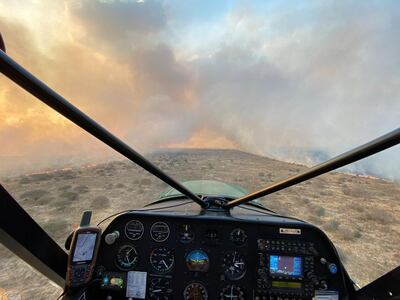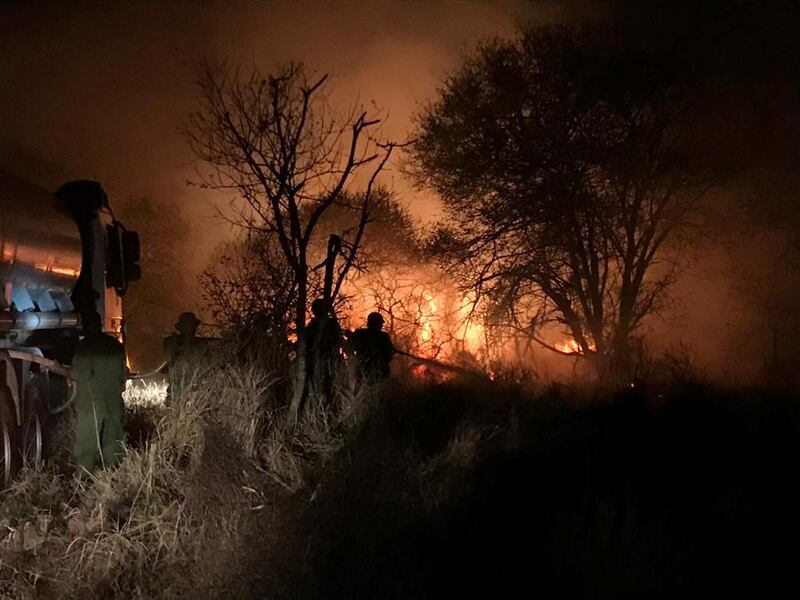In the south-eastern part of Kenya lie two national parks: the Tsavo West National Park and the Tsavo East National Park. The two used to be part of one giant park of the same name - Tsavo - before it was divided into two, with the boundary between the parks consisting of, among other markers, the Nairobi-Mombasa motorway.
Despite the proximity to each other, the ecologies of the parks are different. Tsavo East is marked by flat, dry plains on which tens of thousands of dust-red elephants bulldoze across the park, while Tsavo West is more mountainous, dotted with volcanic cones, and wetter, with a more diverse collection of animals including elephants, bush babies, lions, hippos, and crocodiles.
But, in recent months, a spate of bushfires - around eight in two months - has hit Kenya’s largest national parks. The latest fire, which started on August 8 in Tsavo West, burnt through approximately 630 square kilometres of the park, until its successful containment on August 10.
Several members of park staff believe that the fires were caused by arsonists. The Kenya Wildlife Service, in a statement shared on social media, said: "The fire is suspected to have been lit by arsonists. Police are tracking down these suspected arsonists."

Fred Sigor, principal secretary for the Ministry of Tourism and Wildlife, told participants at a forum for wildlife stakeholders on August 11 that he blamed local herders, honey-gatherers, charcoal-burners and farmers for the blaze.
“We have witnessed a lot of fires in the conservation area. The problem is big and we will not allow our environment to be destroyed deliberately by arsonists,” he said.
As the fire raged on, several organisations, both governmental and non-governmental, were involved in the efforts to quell the blaze.
The KWS, the Kenya Forestry Service, the Kenyan military, the Sheldrick Wildlife Trust, National Youth Service, Finch Hatton Lodge, Taita Sisal Estate, Tsavo Heritage Foundation, and Wildlife Works were among organisations to take the lead in fighting the fire, with a combination of water bowsers, teams of people on the ground, and planes and helicopters involved in the efforts.
Shortly after, a call was made for volunteers who wanted to assist the ground team in its efforts.
Coordinating the ad-hoc teams of volunteers was Jacob Mwaluda Kipongoso, executive chairman of Tsavo Heritage Foundation. He shares the belief that the latest fire was caused by arsonists.
“It could be a guy harvesting honey who got careless, it could be a guy who wanted to graze his cattle in the park but got denied a permit, or it could be charcoal burners,” Mr Kipongoso said.
The fires in the Tsavo ecosystems are an annual event, and the community is usually well-prepared for the barrage of fires that mark the dry season.
But, the last rainy season was pock-marked by heavy rains that, because of a healthier growth of grass, have made this year's blazes heavier. "It happens every year during this time," Mr Kipongoso told The National. "This is standard. It's just that this year there was a lot of rain which led to a lot of grass, and the dry grass fuelled the fire."
Most of the bigger animals were able to run away and escape being harmed by the fire. But a lot of smaller animals, especially crawlers, weren’t so lucky, Mr Kipongoso said. “The small crawlers got trapped in the fire.”
As this is fire season in the Tsavo, more fires are expected in the next few months. The hope then is that the experience of fighting the latest fires helps minimise damage to flora and fauna that dot both Tsavo parks.






